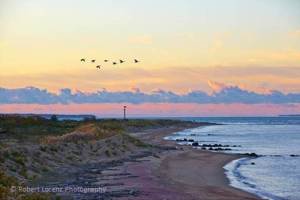Steve Resler, retired scientist and active diver, tells us why Plum Island is the perfect site for underwater research and exploration.
The areas beneath the surface of waters ranging from Long Island to Rhode Island are spectacular. Their physical characteristics transition from the smoothly undulating sandy areas offshore of most of the East Coast to dramatically irregular rocky areas associated with New England. Shoreline and underwater physical characteristics and winds, waves, and tides contribute to a relatively dynamic area conducive to high quality marine ecosystems.
The area is biologically diverse. The transition from a relatively uninterrupted and gently sloping sandy environment to one of irregular rocky substrates provides for amazingly beautiful anemones, sponges, and beds of kelp supporting all manner of other species. Significant numbers of whales, dolphins, seals, marine turtles and sharks, lobsters, and all manner of fishes and other marine life frequent the area, including seasonal tropical species that have ridden and spun off of the warm Gulf Stream as it heads northeastward. All of these species use the area year-round or seasonally, or for important parts of their life cycles. These marine species also support important species above the surface of the water on Plum Island, Great and Little Gull Islands, Fishers Island, and other nearshore terrestrial areas surrounding these waters.

The U.S. government owns Plum Island. It housed an animal disease research facility for decades, although much of the island remains undeveloped. The federal government, through the agency that acts as its landlord (the General Services Administration), has been considering the sale of the island to private entities, or perhaps some other means of disposition of the island.
Since 1995, it’s been a dream of mine to have a major part of these waters designated a marine reserve, preserve, sanctuary, or park that recognizes and protects its characteristics and diverse species. Given the area’s proximity to and access to it from several public and private educational and research institutions in three states, the entire area provides unique opportunities for collaborative, “in depth” coastal nearshore and offshore research.

I have to confess having more than purely altruistic interests, as I was the diving officer in charge of SUNYLAB, a low-cost, “Volkswagen” approach manned undersea lab used in Long Island Sound from 1977 to 1982 and now on display at SUNY Stony Brook’s Engineering College. I’d love to put SUNYLAB or a newer version of it back in service, in this area, to train new scientists and provide them the unique experiences and opportunities to conduct more “in depth” study. No amount of remote sensing or other means of sampling or measuring the marine environment can replace the unique experiences, knowledge and understandings gained from being completely immersed in the marine environment.
Since the area is in three states, it might also provide a long overdue opportunity for the three states and the federal government to formally develop better collaborations for long-term management and protection of this shared area and its associated resources.
Plum Island and its former research and support facilities are ideal for adaptive reuses involving long term, in-depth study of nearshore and offshore areas and resources and related research. New York once had such a facility on Long Island, and there has never been an opportunity to replace it with existing infrastructure and an ideal location from which to conduct relevant research, and from which to administer a comprehensive management program for such a unique area and the opportunities it presents.
Call, write, or visit your respective local, state and federal elected officials in New York, Connecticut, and Rhode Island and ask them to consider this opportunity. Don’t let it slip by, because it’s not likely that anything like it will come again.

In January, 2008, after almost four decades of public service beginning in the early 1970’s with underwater biological surveys in Long Island Sound, Steve C. Resler retired from his position with New York’s Coastal Management Program. Upon retirement, he founded InnerSpace Scientific Diving, providing a wide range of scientific diving primarily for government agencies and academia. As a scientific diver for forty-three years, Steve’s underwater work includes behaviors of octopuses, eradication and control of aquatic invasive species, and colonization of artificial reefs. One of Steve’s colleagues has described him as “…the only person I know who is not trying to keep his head above water.”
